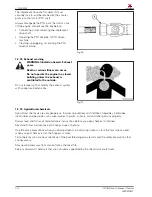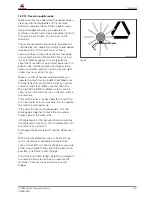
1.2.6 The service manual
Read the table of contents and basic layout. Become familiar with all parts of this service manual. This
service manual gives the technician very important information.
Machine movement when in normal use determines right-hand and left-hand.
This manual covers general safety practices for this machine.
The photos, illustrations, and data used in this manual were current at the time of printing. Inline
production changes can make machines vary from the information in the service manual. The manufacturer
reserves the right to redesign and change the machine as necessary without notification.
WARNING:
In some of the illustrations and photos used in this manual, shields or guards may have
been removed for clarity. Never operate the machine with any shields or guards removed.
If the removal of shields or guards is necessary to make a repair, they must be replaced
before operation.
1.2.7 Operation
1.2.7.1 Prepare for operation
Read and understand all operation instructions and precautions in this manual before you operate the
machine or do the servicing.
Make sure that you know and understand the positions and operations of all controls. Make sure that all
controls are in neutral and that the parking brake is applied before you start the machine.
Make sure that all persons are away from your area of work before you start and operate the machine.
Examine and learn the controls in an area that is clear of persons and obstacles before you start work.
Know the machine dimensions and make sure that you have sufficient space available to operate the
machine. Do not operate the machine at high speeds in crowded areas.
It is important to know and use the correct procedures when you do work around and operate the
machine. Do not let children or unqualified persons operate the machine. Keep others, especially children,
away from your area of work. Do not let others to ride on the machine.
Make sure that the machine is in good condition for operation. Refer to the operator manual. Make sure
that the machine has the correct equipment required by local regulations.
1.2.7.2 Roll over protective structure
The roll over protective structure (ROPS) is effective in reducing injuries during overturns. Overturning a
tractor without ROPS or with the ROPS folded down can result in serious injury or death. Operate with
ROPS folded down only when conditions make this necessary. Return ROPS to upright, locked position as
soon as conditions permit.
Do not weld, drill, or alter the ROPS.
If the tractor has been rolled over or the ROPS frame has been damaged in any manner, the ROPS must be
replaced. Do not attempt to repair a damaged ROPS. If damage does occur, consult your dealer and
replace all damaged parts.
Before using the tractor make sure the ROPS frame is not damaged and it is securely fastened to the
tractor .
Do not attach chains, ropes, or cables to the ROPS for pulling purposes - damage to the ROPS and/or
overturn of the tractor may result. Always pull from the tractor drawbar.
Observe all recommendations and instructions regarding the installation of covers or roofs which are used
as sunshields only, and do not afford the operator protection from falling objects.
GUID-0CC50E5C-AD62-4FFD-9435-62214FEFA5F4 [V1]
[V]
GUID-A25B667B-D7CF-4C75-8AED-C10113104322 [V5]
GUID-171439FB-BBE1-4C99-AF7B-55DDA26F7427 [V2]
1. General
1-8
1700M Series Compact Tractors
4283619M1






































